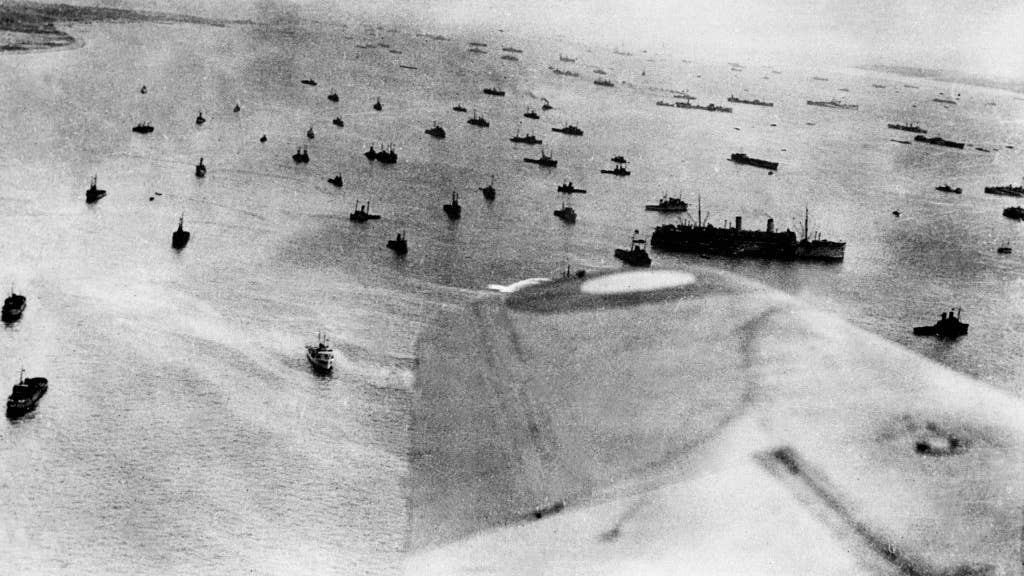D-Day: The weather forecast that liberated a continent

Aerial view taken 06 June 1944 of the Allied Naval forces engaged in the Overlord operation of landing while Allied forces storm the Normandy beaches on D-Day. (Photo by STF / AFP) (Photo by STF/AFP via Getty Images)
SUMMARY
One of the most crucial aspects of the 1944 D-Day landing was how the weather could affect the invasion’s naval and air operations on and above the English Channel. Weather in and of itself had the ability to turn the invasion into a disaster costing thousands of lives and prolonging the war, perhaps for years. One of the most important advisors to the Supreme Allied Commander, American General Dwight Eisenhower, was a British Royal Air Force meteorologist, Group Captain James Stagg. Stagg had the unenviable job of trying to predict the notoriously unpredictable weather over Britain and the English Channel for the invasion.
As it happened, Allied access to trans-Atlantic weather data, denied to German Luftwaffe military weather personnel after 1941, ended up becoming a deciding factor in the success of the invasion. Between the need for favorable weather, a low tide during the early morning of the invasion, and a late-rising moon required the evening prior for the airborne assault, coming up with suitable dates was literally like threading multiple needles with a single thread. As the initial June 5th assault date approached, a developing low-pressure system spinning up in the North Atlantic Ocean near maritime Canada seemed destined to cancel the invasion during the early June period of otherwise favorable conditions.
Continuing to monitor the weather data, Stagg recommended canceling the planned June 5th date. Having accurate data from Canada, Greenland, Iceland, numerous ships at sea, and a dedicated Royal Air Force squadron that flew dangerous, ultra-long range weather reconnaissance missions from the west coast of Scotland, he held out the possibility for a short break in stormy conditions. This would favor a landing on the Normandy coast on June 6. At the same time, with the sparse raw information available to the Luftwaffe weather personnel, they forecasted a two-week period of continuous stormy weather along the French coast.
As observations flowed into Stagg’s meteorological team, a prediction emerged for a ridge of higher pressure, forming off the west Irish coast, to cross over southern England precisely in time to launch the massive flight operations needed to land glider troops and paratroops and enable fighter and attack planes to cover the invasion and allow the huge invasion fleet to set sail. Now a waiting game began to see if further observations would verify the forecast.
Although technically neutral, the Republic of Ireland was still a member of the British Commonwealth during the war, and routine reports of weather conditions were passed to the British meteorological system. Maureen Sweeney and her husband Ted were lighthouse keepers, and weather observers on the coast of County Mayo, jutting out into the Atlantic Ocean in the far west of Ireland. The young couple, whose weather observation and recording duties came under the Irish Met Éireann, was asked to provide round-the-clock hourly observations starting on June 3rd but were given no explanation for the unusual request. The weather worsened, through the day and into the evening, however by the morning of June 4th, conditions improved, and the skies were clearing to the west. Maureen Sweeny provided most of these weather observations during the critical time.
With improving conditions verifying a break in the stormy weather, Group Captain Stagg provided a favorable weather forecast to General Eisenhower on the evening of June 4, 1944. Based on that forecast, the order was given to commence Operation Overlord, the Allied assault on Hitler’s Atlantic Wall, and the start of the liberation of France.
While the weather had cooperated for the Allied invaders, it was rough going in the English Channel for the men in the ships and landing craft on June 6. Some Allied tanks had been modified with dual drives and canvas “skirts” to keep water from getting into the lower driver’s and gunner’s hatches, intended to aid in river crossings. Now these tanks were assigned to “swim “to the invasion beaches from up to three miles out. Very few made it to the beaches, most swamped by the rough water, and sinking with most of their crews. They still reside on the sea bottom off of the Normandy coast today.
With no port facilities in the invasion zone, a top-secret scheme of “gooseberries,” derelict ships sunk close to shore as breakwaters, and “mulberries,” giant floating concrete boxes sunk for use as docks. was devised to provide an artificial harbor for offloading cargo ships after the beaches were secured. The stormy weather that resumed soon after June 6th took a heavy toll on these arrangements.
On June 19, 2021, the rare U.S. House of Representatives Medal, only given to those who have performed “Laudable Deeds” for the United States, was presented to a then 98-year-old Maureen Sweeney.
SHARE
